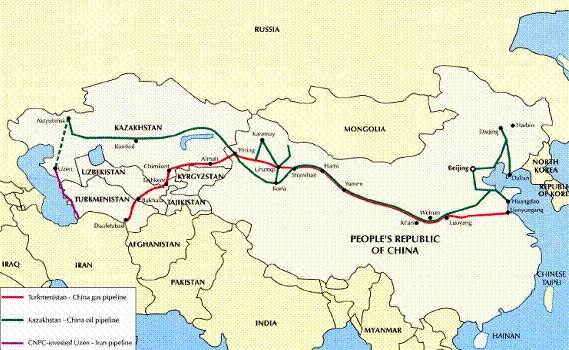Central Asia Pipeline Carried 80 Billion M³ Gas
Central Asia-China gas pipeline is the first transnational natural gas pipeline in China. The pipeline begins from Turkmenistan and Uzbekistan border, crosses central Uzbekistan and southern Kazakhstan, and enters in China at Khorgos port. It reaches a length of 1,883 km and is designed with a transportation capacity of 30 billion m³ to 40 billion m³ per year. When entering in China, it is linked together with the second line of west-east gas pipeline, supplying fuel for 400 million people who live in Yangtze River and Pearl River Delta regions.
On December 14, 2009, the leaders of China, Kazakhstan, Turkmenistan and Uzbekistan started vent valve together at Turkmenistan NO.1 natural gas treatment plant, which meant that central Asia gas pipeline came into service officially.
In recent years, the capacity of central Asia gas pipeline has a breakthrough in China. Gas conveyed by this line exceeded 70 billion cubic meters On December 25, 2013. The equivalent number in 2011 was only 10 billion. By May 2014, the central Asia–China pipeline has transmitted 80 billion cubic meters of gas in five years.
Last month, Natural gas from Turkmenistan was carried in Line C of Asia-China gas pipeline the first time. PetroChina said that supporting facilities of the new line will be fully completed at the end of 2015, with convey ability of 25 billion m³/year. Added with Line A and Line B, the total transportation ability should reach 55 billion m³/year, which can meet at least 1/5 consumption demand of domestic natural gas.

Related News
- UHV High-Neck Flange Welding
- Application of High-Neck Flange to UHV Steel Pipe Tower
- Analysis of the Cracking Cause of High-Neck Flanges
- Anchor Flanges for the East-West Gas Transmission Project
- Analyzing the Corrosion of Blind flanges
- Research on the Processing Technology of SS316L Flanges
- Flanges Formed by Bending
- Internal Threads of Stainless Steel Flanges
- Installation Guide for Threaded Flanges
- Practicality of Slip On Flanges in Industrial Pipelines

